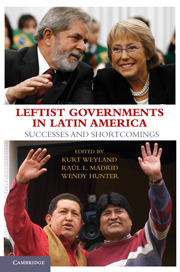Book contents
- Frontmatter
- Contents
- Acknowledgments
- Acronyms and Abbreviations
- Contributors
- 1 The Performance of Leftist Governments in Latin America: Conceptual and Theoretical Issues
- 2 The Repeating Revolution: Chávez's New Politics and Old Economics
- 3 The Challenge of Progressive Change under Evo Morales
- 4 The Chilean Left in Power: Achievements, Failures, and Omissions
- 5 From Cardoso to Lula: The Triumph of Pragmatism in Brazil
- 6 Lula's Administration at a Crossroads: The Difficult Combination of Stability and Development in Brazil
- 7 The Policies and Performance of the Contestatory and Moderate Left
- Bibliography
- Index
6 - Lula's Administration at a Crossroads: The Difficult Combination of Stability and Development in Brazil
Published online by Cambridge University Press: 05 June 2012
- Frontmatter
- Contents
- Acknowledgments
- Acronyms and Abbreviations
- Contributors
- 1 The Performance of Leftist Governments in Latin America: Conceptual and Theoretical Issues
- 2 The Repeating Revolution: Chávez's New Politics and Old Economics
- 3 The Challenge of Progressive Change under Evo Morales
- 4 The Chilean Left in Power: Achievements, Failures, and Omissions
- 5 From Cardoso to Lula: The Triumph of Pragmatism in Brazil
- 6 Lula's Administration at a Crossroads: The Difficult Combination of Stability and Development in Brazil
- 7 The Policies and Performance of the Contestatory and Moderate Left
- Bibliography
- Index
Summary
The present chapter examines what Brazil's so-called leftist governments have done right for the development of the country. It seeks to identify the principal policy issues and decisions of the Fernando Henrique Cardoso and Luiz Inácio Lula da Silva administrations from 1994 until the middle of 2008. Our main argument is that a new pattern of capital accumulation that was beginning to be established by the Cardoso government has been extended and consolidated under the Lula da Silva administration. At the same time, a new set of social policies, particularly programs for the very poor, were implemented by the Cardoso government and have been expanded and deepened under the Lula administration. In other words, a significant change in Brazil's social policy strategy (Draibe 2003) that had been initiated between 1996 and 2002 was intensified and strengthened between 2003–08.
Our purpose in this chapter is to show that these new social and economic tendencies have shaped the most important priorities of government action and state intervention from 2003 until now, with three principal results: First, the government's actual agenda has diverged in key ways from the program presented in 2002 by Lula da Silva's political coalition in the campaign for the national elections of that year. The electoral platform of the Workers' Party (Partido dos Trabalhadores – PT) reflected long-standing party goals, but the government's policy approach has differed significantly from that platform.
- Type
- Chapter
- Information
- Leftist Governments in Latin AmericaSuccesses and Shortcomings, pp. 124 - 139Publisher: Cambridge University PressPrint publication year: 2010
- 2
- Cited by

